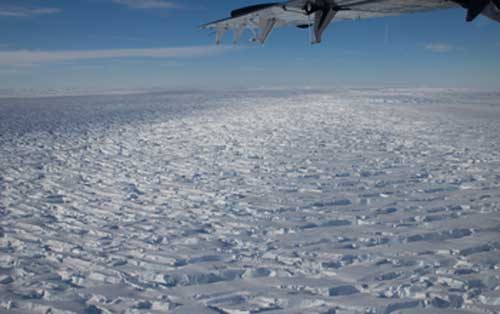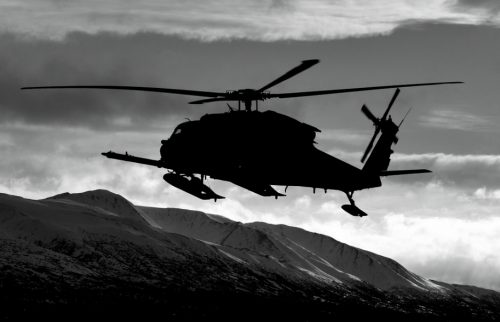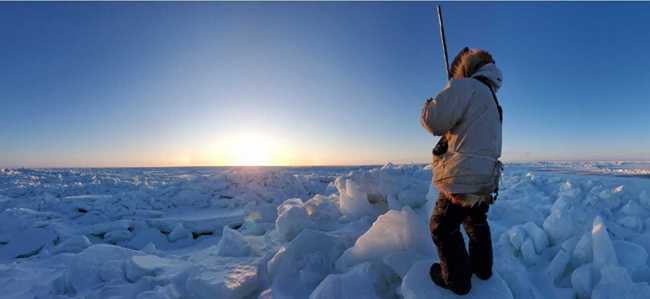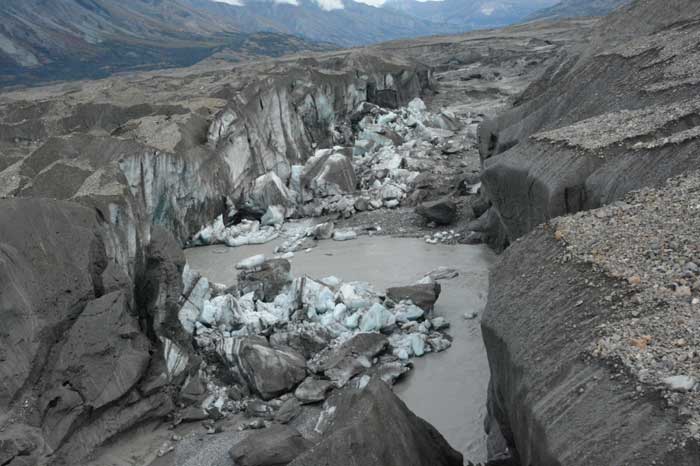
One by one, curious mountaineers emerged from yellow tents and turned their ears to the midnight soundscape — of fast crackles and rippling trickles, of many notes of water — atop the south Gabriel Icefall of C’ulc’ena’ Łuu’ (Gulkana Glacier).
The nine Girls* On Ice Alaska participants watched and listened as the moraines changed before them. Puddles, ponds and glacial streams deepened in the blue-gray valley, the snowy basecamp for 2023’s 12-day science- and art-focused alpine expedition designed and supported by the University of Alaska Fairbanks’ International Arctic Research Center.
At more than 4,000 feet above sea level in the eastern Alaska Range, the young explorers were quick to consider their science daily lessons. Affectionately called “pingos,” after the ice-cored hillocks in Arctic landscapes, the students connected the alpine environment with downstream, low-elevation habitats — reminders that cryospheric life atop an alpine glacier is an interconnected affair.
“The pingos at Girls* On Ice are always so interested in the transdisciplinary aspects of ecosystems, often even more so than adults,” said Megan Pittas, a coordinator with the Alaska Climate Adaptation Science Center at UAF and 2023’s on-site Girls* On Ice Alaska coordinator. “Our students are really excited to make those connections.”
A ‘shining science star’
Perhaps no one was more interested in these meltwaters than then-17-year-old Teslin Brannan, who grew up in nearby Salcha, Alaska. Now 18, she recently graduated from North Star College, a new program on the UAF Troth Yeddha’ Campus that lets high school juniors and seniors take college classes. Since she was in kindergarten, Brannan has monitored the water quality in the Tanana River watershed, seeing firsthand how riparian health is so crucial to her community.
In 2022, Brennan analyzed data she helped collect during a decade-long study of Piledriver Slough, where a levee had cut off its head. Her data revealed that the levee contributed to a water temperature increase of 6 degrees Celsius over just 10 years. And when the Girls* On Ice Alaska participants drove from Fairbanks to their ascent’s beginnings in 2023, Brannan pointed out where locals were placing lawn chairs on the Tanana River’s bank and making bets on which seat would fall first, victims of encroaching riverbank erosion.
“What I thought was really neat about the Gulkana Glacier trip was learning how many different ecosystems start with glaciers,” she said. “Meltwater goes into rivers, which eventually feeds into oceans, and learning all the science behind it was really neat.”
Atop the contours of C’ulc’ena’ Łuu’, which means “cutting stream glacier” in the Ahtna language, Brannan helped lead a group in collecting water temperature and pH readings in four locations on the glacier and one in Phelan Creek. Though she wasn’t initially sure how these measurements might be analyzed, she knew from experience that proactive data collection — especially at C’ulc’ena’ Łuu’, a reference glacier for the World Glacier Monitoring Service — was good scientific practice. Equipped with combined pH and temperature meters and their own water bottles, the group’s study met international protocols for research best practices set by the Global Learning and Observations to Benefit the Environment program.
Gulkana goes global

2023 Girls* On Ice participants sit in a sleeping bag circle at their camp on the Gulkana Glacier.
Several months later, as the first high school student to ever study in UAF’s 300-level Introduction to Watershed Management class, Brannan’s instincts and careful data collection proved fruitful.
Christi Buffington, a science education specialist, program manager, and adjunct faculty at IARC and UAF, waived all class prerequisites, due to Brannan’s extensive experience and expertise. Buffington taught the implications of pH in a glacial ecosystem and the impacts on downstream habitats. With this understanding, an experiment took shape: Brannan was curious if the physical location — including elevation, ice formation and the type of sediment or rock present — of the collected water samples affected both pH and temperature.
“In Christi’s class, one thing that really fascinated me was learning how limestone can affect pH,” Brannan said. “That was the coolest thing that I learned.”
Brannan’s hypothesis was confirmed. Her analysis found that water samples at higher elevations recorded the lowest temperatures. The sample with the highest temperature — taken in standing water — also recorded the lowest pH. Crucially, she concluded that the downstream flow of these waters were within the optimal pH range for salmon, between seven and eight.
This spring, she submitted her findings — “Water Temperature and pH Measurements on Gulkana Glacier and Phelan Creek, Alaska” — at the GLOBE International Virtual Science Symposium. On Earth Day, a judging panel recognized it as one of the highest-ranking projects. For her efforts, Brannan earned a trip to attend and present at the 2024 GLOBE Annual Meeting for Climate Resilience this July in Fredonia, New York.
“I think that Teslin saw herself as a member of an international community of scientists,” said Buffington, who was also on the trip. “She has the competence to really be a leader in science, but she also has the humility to listen to other people. And at GLOBE, she learned from people and cultures from all over the world.”
Coming home, and new beginnings
While an international community of glaciologists, researchers and fellow students learned from Brannan’s research, her findings hold special importance back home.
C’ulc’ena’ Łuu’ is an important recharge area for the Delta-Clearwater River, which provides spawning habitat for coho salmon, a crucial species for subsistence and commercial fishing. In recent years, upper Tanana River drainage coho runs have been down significantly compared to historic averages, according to the Alaska Department of Fish and Game’s 2023 Yukon River fall season summary.
The next generation of Alaska scientists, led by Girls* On Ice, are well-aware of this local impact.
“I think every single student mentioned salmon in their [end-of-expedition] presentations, which warmed my heart,” Pittas said. “Because that’s what they’re passionate about, that’s what makes sense to them, and that was where they could connect.”
That Brannan’s research took last summer’s expedition to a global stage is one of numerous success stories from Girls* On Ice’s alumnae, many of whom have pursued careers in glaciology and other scientific disciplines.
“If you had a good time at Girls* On Ice,” Pittas said, “you can continue to do this for your life.”
This fall, Brannan will attend Linfield University on an academic scholarship and plans to major in environmental science. She’s excited to explore the ecosystems Oregon has to offer, while always cherishing the lands and waters where she grew up.
“One of the biggest things I’ve learned is that I personally can affect the things around me,” Brannan said. “A big thought process nowadays is, ‘I’m just one person, I can’t do much to change things.’ But the more you learn, you realize all the things that you can do, even something as simple as picking up trash from the side of the road. Anyone can be a scientist.”
ADDITIONAL CONTACT: Christi Buffington, 907-474-2794, cbuffington@alaska.edu
[content id=”79272″]








